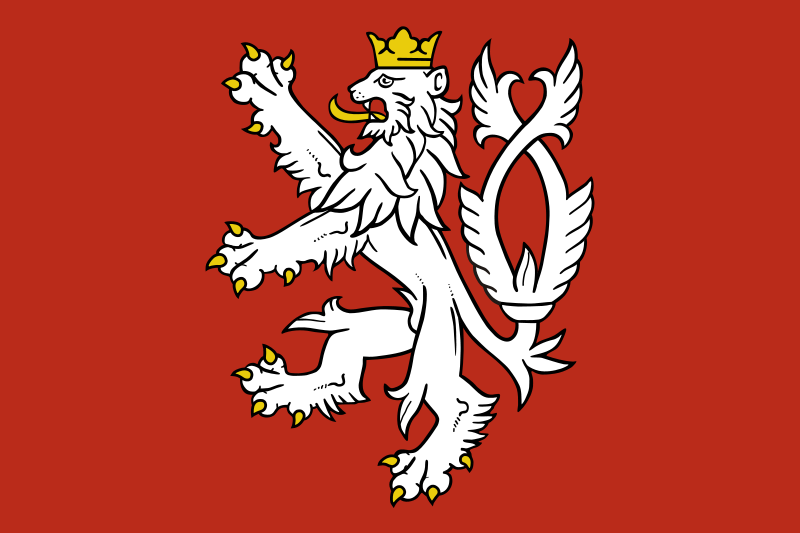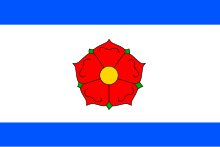La bandera de Bohemia es una bandera histórica, que ahora forma parte del diseño de la bandera moderna de la República Checa . La bandera, un bicolor horizontal, estaba basada en los colores de los antiguos monarcas de Bohemia .
La bandera heráldica de Bohemia (la bandera de Bohemia en forma de bandera con escudo de armas) se describe y dibuja, por ejemplo, en la obra de Jacob Koebel: Wapen des heyligen römischen Reichs teutscher Nation from 1545. [1] La más antigua La descripción de esta bandera (siglo XIII) se puede leer en la crónica de Ottokar aus der Gaal (Otacher ouz der Geul, Ottokar von Steiermark) (* aproximadamente 1265; † entre 1318 y 1322): Die Steirische Reimchronik . [2]
Historia y uso [ editar ]
"Los colores de la bandera, blanco y rojo, se derivaron del escudo de armas del Rey de Bohemia (león plateado en un campo rojo) que se le otorgó al rey Vladislao I en el siglo 12. Esto rápidamente se convirtió en el escudo de brazo de todo el reino ". [5]
La representación en color de los brazos de Bohemia más antigua que se conserva, está representada por el fresco en la sala del castillo de Gozzoburg en Krems an der Donau, que data de principios de la década de 1270. [6] Una descripción adicional se puede encontrar en el manuscrito de abbes Kunigundede la década de 1310. [7]
Las banderas bicolor blanco-rojo fueron llevadas a la batalla por los ejércitos de los reyes bohemios y en el siglo XIX los colores fueron adoptados por el movimiento nacional checo . Pero cuando los objetivos del movimiento se cumplieron en 1918 con la restauración del estado checo independiente , la necesidad de los símbolos significativos, incluida una bandera que no era idéntica a la de la vecina Polonia , llevó a la aprobación de la nueva bandera de Checoslovaquia. en 1920. Esta nueva bandera aún incluía las franjas horizontales blancas y rojas de la bandera de Bohemia.
En 1990, la bandera de Bohemia fue adoptada como la bandera oficial de la República Checa , entonces parte de la República Federativa Checa y Eslovaca (ČSFR, 1990–1992). [8] La bandera fue adoptada en reacción a la adopción de símbolos eslovacos separados. Sin embargo, la bandera checa se usó mucho menos que la bandera más ancha de Checoslovaquia , mientras que la bandera de Eslovaquia (entonces sin escudo de armas y, por lo tanto, idéntica a la bandera de la República Eslovaca de la Segunda Guerra Mundial [9]) fue ampliamente utilizado en Eslovaquia. Esta diferencia reflejó las tendencias separatistas prevalecientes en la República Eslovaca y las tendencias federalistas en la República Checa. Otro problema, nuevamente, fue la similitud de la bandera de Bohemia con la bandera de la vecina Polonia , porque la única diferencia era la proporción 2: 3 (la bandera polaca es 5: 8). Por estas razones, los políticos checos decidieron preservar la bandera de Checoslovaquia como el símbolo del estado con el que se identificó a la mayoría de la sociedad checa .
Desde 1993, la bandera de Bohemia no tiene estatus legal y rara vez se ve hoy en la República Checa.


La bandera actual de Český Krumlov , República Checa , fue entregada formalmente a la ciudad por el presidente de la Cámara de Diputados Václav Klaus el 14 de junio de 2001.
La bandera anterior de la ciudad era verde y blanca, pero no había sido heráldicamente correcta . La nueva bandera consiste en franjas azules, blancas y azules en la proporción 1: 4: 1, con una rosa roja de cinco pétalos en el centro. La relación de la bandera es 2: 3. Se recomienda que la rosa esté entre la mitad y dos tercios del ancho de la bandera.
La rosa proviene de un emblema de la poderosa familia Rožmberk , que fue importante en la historia de Krumlov.
flag of Moravia, unlike the provincial Moravian coat of arms, does not exist, because such a flag has never been granted to Moravia. However, there are several documented variants of Moravian flags used in the past. The first recorded version dates from the mid-13th century.
The oldest history[edit]
There is a description of a Moravian flag in the chronicle of Ottokar aus der Gaal (also known as Otacher ouz der Geul or Ottokar von Steiermark; born about 1265, died between 1318 and 1322): Die Steirische Reimchronik.[2]
The history of the Moravian flag is very varied and begins in the 13th century in the context of the relations between Bohemia and Moravia organized within the construction of a centralized monarchy by the last kings of the Přemyslid dynasty. The colouring of the flag (or banner) was according to vexillological rules derived from the colours of heraldic coats of arms since the Middle Ages.[1]
From the reign of Ottokar II of Bohemia, Moravia's coat of arms features a silver-red checquered eagle with a golden crown and claws, which looks to the right and is placed on a blue field.
The oldest surviving full-colour depiction of the coat of arms of Moravia is in a fresco in the hall of Gozzoburg Castle in Krems an der Donau, dating to the early 1270s.[5] The checquered eagle is documented in a depiction from 1286 and later in the late 13th and early 14th century.[6]
The colours of the checquered eagle were derived from the colours of the Bohemian lion (a silver lion on a red shield) and express the connection with the Bohemian king of Moravia and Bohemian monarchy, as, for example, historian Vladimír Růžek recalls.[7] One of the first documented illustrations of the banner of Moravia is the view in the 1407 Gelnhausen Codex, which depicts the Moravian Margrave Jobst of Moravia with a blue banner on which the Moravian white and red eagle is placed with a yellow crown and yellow armor without a shield.[1]
Modern age[edit]
The heraldic flag of Moravia (the flag of Moravia in the form of the flag with coat of arms) is described and drawn for example in the work of Jacob Koebel: Wapen des heyligen römischen Reichs teutscher Nationfrom 1545.[8]
Historically, there were several versions of the widely used and documented Moravian flags, which were mainly used during the 19th century in parallel to bicolours and tricolours derived from tinctures of provincial coat of arms.[9][10] According to some authors, therefore, the Moravian flag consists of three horizontal strips of red, white, and blue.[11]This color combination was the flag of the Moravian patriots in the 19th century. A delegation of the Moravians to the Slavonic Congress in Prague in 1848 allegedly marched under a tricolour with the top horizontal stripe white, the middle red and the bottom blue.[12] White, red and blue colors are referred to as Moravia in the Nový prostonárodní popis Čech, Moravy a Slezska from 1854 and in some textbooks from the 19th century.[13] According to Ivan Štarha, the Moravian colours in 1915 were white, red and blue, and between the years 1915 and 1918 yellow, red and blue.[14][15] The Czechoslovak Republic restored the white or silver color to the Moravian coat of arms, but the color is not defined in the provincial status flags / banners Act No. 252/1920. Country flag do not know the later legal regulations (Act no. 269/1936, Law no. 222/1939, no. 163/1960, and now valid Acts no. 3/1993 Coll., No. 352/2001 Coll.).[clarify][16][17][18]
Today, a yellow-red bicolour is sometimes used as the flag of Moravia, especially by some Moravian parties, associations and other organizations.[19][20] The yellow-red bicolour has been used along with other bicolours and tricolours since the second half of 19th century, according to certain authors (L. E. Havlík, M. Hlinomaz).[12][21]
Hereinafter referred to as Morava: k státoprávnímu postavení země v průběhu věků.[9][22] As stated by M. Hlinomaz:
The historian Ivan Štarha argues that Moravia was never awarded the flag.[13] To today's yellow-red bicolour is sometimes added the provincial coat of arms with a red-gold checquered eagle.[19] The red-gold checquered eagle variant was introduced in 2007, and was recommended by some members and supporters of the Moravian National Community to avoid a possible misidentification with other flags, for example the flag of the capital city Prague, which also consists of yellow and red horizontal stripes. This option is criticized by some Bohemian (Czech) nationalist experts.[23][24][25][26]
Both of these versions, however, have been criticized by certain experts approached by the media (specifically historian M. Řepa, vexillologist K. Müller, and heraldist Jiří Louda).[23][24][25][26]
The appearance of the flag has been a subject of discussion for more than 100 years.[27] One variant consists of two bars, a yellow bar in the upper half, and a red bar in the lower half.














No hay comentarios:
Publicar un comentario